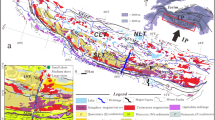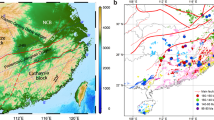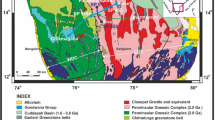Abstract
The southern boundary between India and the Tibetan Plateau represents a classical case of continental subduction, where the Indian continental lithosphere is subducted northwards beneath the Tibetan Plateau1,2,3,4,5,6. At the northern boundary, southward subduction of Asian lithosphere beneath the Tibetan Plateau has also been proposed7, but imaging has been hampered by inadequate data quality. Here we analyse the plate tectonic structure of the northern boundary between Tibet and Asia using the S receiver function technique. Our passive source seismic data build on, and extend further northwards, the existing geophysical data from the International Deep Profiling of Tibet and the Himalaya project8,9,10. We detect, beneath central and northern Tibet, a relatively thin, but separate, Tibetan lithosphere overriding the flat, southward subducting Asian lithosphere. We suggest that this overriding Tibetan lithosphere helps to accommodate the convergence between India and Asia in central and northern Tibet. We conclude that the Tibetan–Himalayan system is composed of three major parts: the Indian, Asian and Tibetan lithospheres. In the south, the Indian lithosphere underthrusts Tibet. In central and northern Tibet a separate, thin Tibetan lithosphere exists, which is underthrust by the Asian lithosphere from the north.
This is a preview of subscription content, access via your institution
Access options
Subscribe to this journal
Receive 12 print issues and online access
$259.00 per year
only $21.58 per issue
Buy this article
- Purchase on Springer Link
- Instant access to full article PDF
Prices may be subject to local taxes which are calculated during checkout



Similar content being viewed by others
References
Zhao, J. et al. The boundary between the Indian and Asian tectonic plates below Tibet. Proc. Natl Acad. Sci. USA 107, 11229–11233 (2010).
Kumar, P., Yuan, X., Kind, R. & Ni, J. Imaging the colliding Indian and Asian lithospheric plates beneath Tibet. J. Geophys. Res. 111, B06308 (2006).
Kind, R. & Yuan, X. H. Seismic images of the biggest crash on Earth. Science 329, 1479–1480 (2010).
Li, C., van der Hilst, R. D., Meltzer, A. S. & Engdahl, E. R. Subduction of the Indian lithosphere beneath the Tibetan Plateau and Burma. Earth Planet. Sci. Lett. 274, 157–168 (2008).
Bijwaard, H. & Spakman, W. Non-linear global P-wave tomography by iterated linearized inversion. Geophys. J. Int. 141, 71–82 (2000).
Zhang, Z. et al. Seismic signature of the collision between the east Tibetan escape flow and the Sichuan Basin. Earth Planet. Sci. Lett. 292, 254–264 (2010).
Tapponnier, P. et al. Geology–Oblique stepwise rise and growth of the Tibet Plateau. Science 294, 1671–1677 (2001).
Zhao, W. & Nelson, K. D. Deep seismic-reflection evidence for continental underthrusting beneath southern Tibet. Nature 366, 557–559 (1993).
Brown, L. D. et al. Bright spots, structure, and magmatism in southern Tibet from INDEPTH seismic reflection profiling. Science 274, 1688–1690 (1996).
Mechie, J., Kind, R. & Saul, J. in The Seismological Structure of the Tibetan Plateau Crust and Mantle Down to 700 km Depth 353 (eds Gloaguen, R. & Ratschbacher, L.) 109–125 (Geol. Soc. Lon. Spec. Publ., 2011).
Zhao, W. et al. Seismology across the northeastern edge of the Tibetan Plateau. EOS Trans. Am. Geophys. Union 48, 487–488 (2008).
Yuan, X., Ni, J., Kind, R., Mechie, J. & Sandvol, E. Lithospheric and upper mantle structure of southern Tibet from a seismological passive source experiment. J. Geophys. Res. 102, 27491–27500 (1997).
Kosarev, G. et al. Seismic evidence for a detached Indian lithospheric mantle beneath Tibet. Science 283, 1306–1309 (1999).
Owens, T. J., Randall, G. E., Wu, F. T. & Zeng, R. PASSCAL instrument performance during the Tibetan Plateau passive seismic experiment. Bull. Seismol. Soc. Am. 83, 1959–1970 (1993).
Zhu, L. & Helmberger, D. V. Moho offset across the northern margin of the Tibetan Plateau. Science 281, 1170–1172 (1998).
Vergne, J. et al. Seismic evidence for stepwise thickening of the crust across the NE Tibetan Plateau. Earth Planet. Sci. Lett. 203, 25–33 (2002).
Jiang, M. et al. Crustal thickening and variations in architecture from the Qaidam basin to the Qang Tang (North-Central Tibetan Plateau) from wide-angle reflection seismology. Tectonophysics 412, 121–149 (2006).
Karplus, M. S. et al. Injection of Tibetan crust beneath the south Qaidam Basin: Evidence from INDEPTH IV wide-angle seismic data. J. Geophys. Res. 116, B07301 (2011).
Yin, A., Dang, Y., Zhang, M., Chen, X. H. & McRivette, M. W. Cenozoic tectonic evolution of the Qaidam basin and its surrounding regions (Part 3): Structural geology, sedimentation, and regional tectonic reconstruction. GSA Bull. 120, 847–876 (2008).
Kind, R. et al. Seismic images of crust and upper mantle beneath Tibet: Evidence for Eurasian plate subduction. Science 298, 1219–1221 (2002).
Wittlinger, G., Farra, V., Hetenyi, G., Vergne, J. & Nabelek, J. Seismic velocities in Southern Tibet lower crust: A receiver function approach for eclogite detection. Geophys. J. Int. 177, 1037–1049 (2009).
Nabelek, J. et al. Underplating in the Himalaya–Tibet collision zone revealed by the Hi-CLIMB experiment. Science 325, 1371–1374 (2009).
Meyer, B. et al. Crustal thickening in Gansu–Qinghai, lithospheric mantle subduction, and oblique, strike-slip controlled growth of the Tibet Plateau. Geophys. J. Int. 135, 1–47 (1998).
Yin, Y. & Harrison, T. M. Geologic evolution of the Himalayan–Tibetan orogen. Annu. Rev. Earth Planet. Sci. 28, 211–280 (2000).
Barazangi, M. & Ni, J. Velocities and propagation characteristics of Pn and Sn beneath the Himalayan arc and Tibetan Plateau: Possible evidence for underthrusting of Indian continental lithosphere beneath Tibet. Geology 10, 179–185 (1982).
McNamara, D. E., Walter, W. R., Owens, T. J. & Ammon, C. J. Upper mantle velocity structure beneath the Tibetan Plateau from Pn travel time tomography. J. Geophys. Res. 102, 493–505 (1997).
Hearn, T. M. et al. Uppermost mantle velocities beneath China and surrounding regions. J. Geophys. Res. 109, B11301 (2004).
Acknowledgements
We thank the station pool of the GFZ Potsdam (www.gfz-potsdam.de/gipp) and the NERC geophysical equipment pool, Seis-UK node (University of Leicester, www.le.ac.uk/seis-uk) for providing seismic stations and support. This research was funded by the CGS-1212010511809 in China, NSF-EAR-CD-0409939 in the USA and the Deutsche Forschungsgemeinschaft and the GFZ Potsdam in Germany.
Author information
Authors and Affiliations
Contributions
W.Z., J.M., R.K., R.M., F.T. and Z.W. planned the field experiment. J.M., Z.W., D.S., H.S., G.X., M.K. and F.T. carried out the field experiment. P.K., J.M., R.K. and M.K. did the data analysis and wrote the manuscript.
Corresponding author
Ethics declarations
Competing interests
The authors declare no competing financial interests.
Supplementary information
Supplementary Information
Supplementary Information (PDF 2791 kb)
Rights and permissions
About this article
Cite this article
Zhao, W., Kumar, P., Mechie, J. et al. Tibetan plate overriding the Asian plate in central and northern Tibet. Nature Geosci 4, 870–873 (2011). https://doi.org/10.1038/ngeo1309
Received:
Accepted:
Published:
Issue Date:
DOI: https://doi.org/10.1038/ngeo1309
This article is cited by
-
The Global Crust and Mantle Gravity Disturbances and Their Implications on Mantle Structure and Dynamics
Surveys in Geophysics (2024)
-
Three-dimensional kinematics of the India–Eurasia collision
Communications Earth & Environment (2023)
-
Steep subduction of the Indian continental mantle lithosphere beneath the eastern Himalaya revealed by gravity anomalies
Science China Earth Sciences (2023)
-
Upper-Mantle Velocity Heterogeneity of Eastern Tibetan Plateau from Teleseismic P-Wave Tomography and Its Tectonic Implications
Journal of Earth Science (2023)
-
Timing and mechanisms of Tibetan Plateau uplift
Nature Reviews Earth & Environment (2022)



